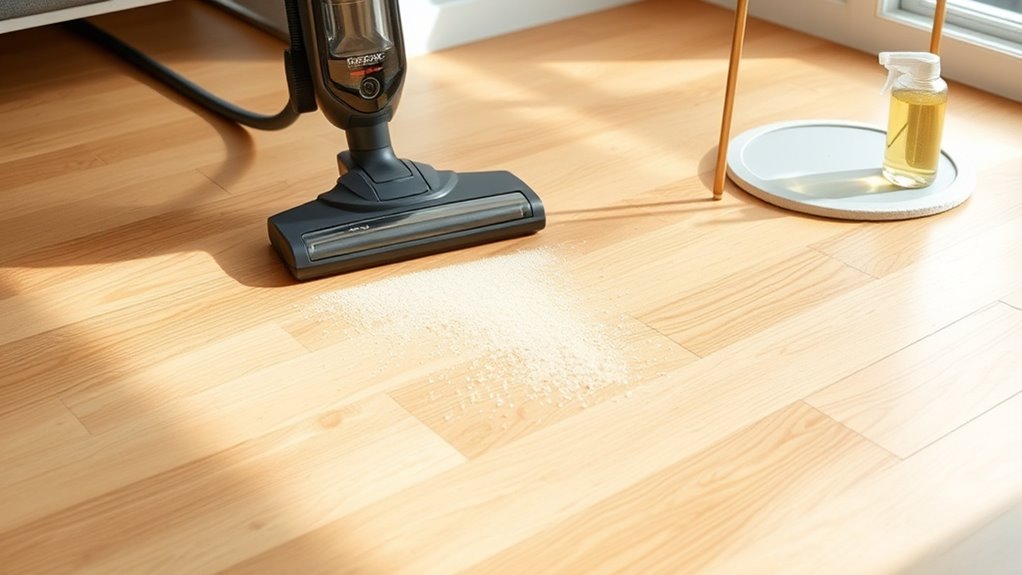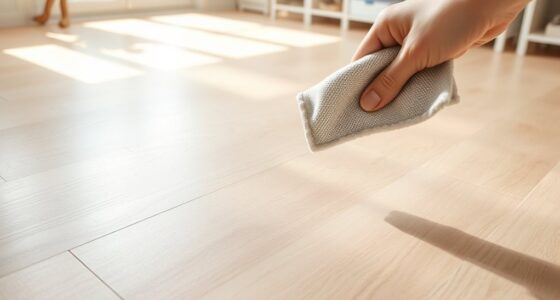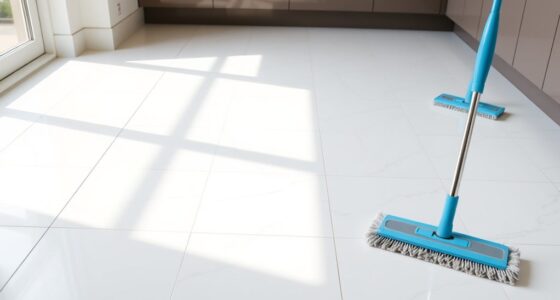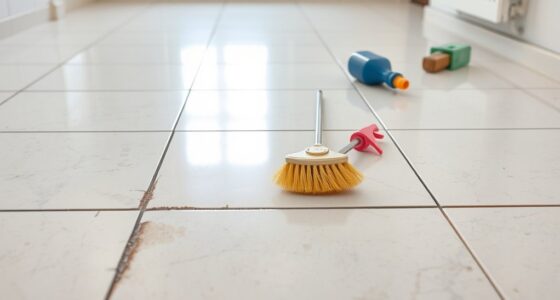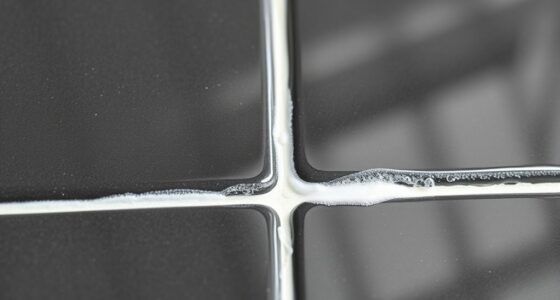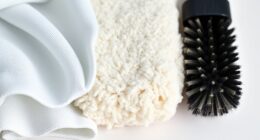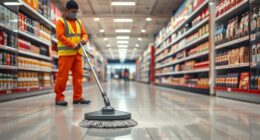To keep dust under control on sealed hardwood floors safely, sweep or vacuum daily with a HEPA filter to trap fine particles, and use microfiber dust mops or damp cloths to pick up dust without stirring it up. Regularly wash bedding and curtains, and consider air purifiers in key areas to reduce airborne allergens. Consistent cleaning and proper filtration create a healthier environment—if you want more tips, keep exploring effective dust control strategies.
Key Takeaways
- Sweep or vacuum daily with a HEPA-filter vacuum to remove dust without dispersing allergens.
- Use microfiber dust mops and damp cloths regularly to trap dust effectively on floors and surfaces.
- Place high-quality HEPA air purifiers in key areas to continuously filter airborne dust and allergens.
- Wash bedding, curtains, and soft furnishings regularly to reduce trapped dust and dust mites.
- Declutter spaces to minimize dust accumulation and simplify routine cleaning efforts.
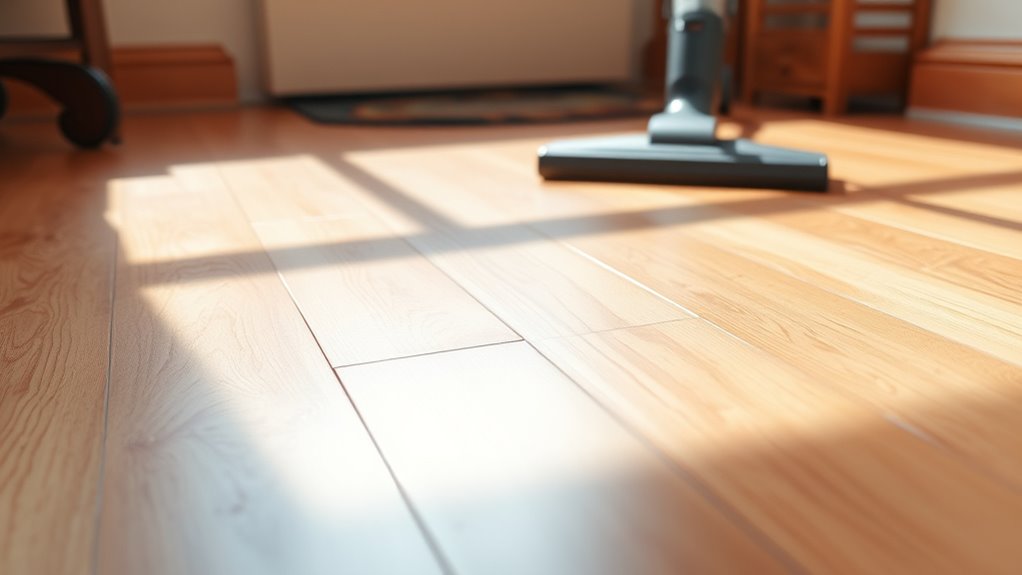
Sealed hardwood floors can markedly reduce dust accumulation, but they still require proper maintenance to keep dust at bay. While the sealing process helps prevent dirt and debris from settling into the wood, dust particles can still settle on the surface and become airborne if not cleaned regularly. To create an allergy-safe routine, you need a consistent cleaning schedule that prioritizes dust removal. Establishing a routine—such as sweeping or vacuuming daily—can significantly cut down on dust buildup. Use a vacuum cleaner equipped with a HEPA filter, as it traps fine particles that can trigger allergies, ensuring cleaner air circulation. Incorporate microfiber dust mops or cloths into your routine, as they effectively pick up dust without dispersing it into the air.
Maintaining sealed hardwood floors requires daily sweeping and HEPA vacuuming for allergy prevention.
In addition to regular cleaning, investing in air purifiers plays an essential role in maintaining a dust-free environment. Air purifiers with HEPA filters capture airborne dust, pollen, pet dander, and other allergens, improving overall indoor air quality. Place them strategically around your living space, especially in high-traffic or allergen-sensitive areas like bedrooms or living rooms. Running air purifiers continuously helps guarantee that dust particles don’t circulate freely, reducing allergy symptoms and creating a healthier atmosphere. Keep in mind that filter replacement is crucial; check your purifier’s guidelines and change filters as recommended to maintain ideal performance.
Your cleaning schedule should also include wiping down surfaces with a damp cloth or microfiber cloth, as dry dusting can stir up particles into the air. Pay particular attention to baseboards, furniture, and vents, which tend to attract dust over time. Regularly wash or replace bedding and curtains, as these fabrics trap dust and allergens that can easily become airborne. Decluttering your space minimizes dust traps, making cleaning more effective and less time-consuming. Consider using allergen-proof covers on pillows and mattresses to prevent dust mites from settling and aggravating allergies. Additionally, understanding maintenance and cleaning guidelines for air purifiers ensures they operate at peak efficiency and prolong their lifespan.
Maintaining a dust-controlled environment on sealed hardwood floors isn’t just about cleaning; it’s about creating a routine that continually minimizes dust exposure. Combining a strict cleaning schedule with the strategic use of air purifiers ensures your home remains cleaner and healthier. Staying consistent with these habits can dramatically improve indoor air quality, reduce allergy symptoms, and prolong the beauty of your sealed hardwood floors. Remember, a proactive approach is key to controlling dust, making your living space more comfortable and allergy-friendly every day.
Frequently Asked Questions
Can Sealed Hardwood Floors Trap Allergens More Than Unsealed?
Sealed hardwood floors don’t trap allergens more than unsealed, despite some sealed floor myths. In fact, sealing reduces dust and allergen buildup by creating a barrier that prevents particles from settling into the wood. Regular cleaning and proper sealing lower allergy trapping potential, making your home healthier. So, you can confidently choose sealed floors, knowing they help control dust and allergens better than unsealed options.
Are There Specific Cleaning Tools Best for Allergy Safety?
You should use a high-quality microfiber cloth for dusting your sealed hardwood floors, as it traps allergens effectively. Pair this with an air purifier to filter airborne particles, ensuring a cleaner environment. Avoid harsh chemicals or sweeping with traditional brooms, which can stir up dust. Regularly cleaning with these tools helps reduce allergen buildup, making your home safer and more comfortable for allergy sufferers.
How Often Should I Perform Deep Cleaning for Allergy Prevention?
You should perform deep cleaning at least once every season to prevent allergen buildup. Regular seasonal cleaning helps remove accumulated dust, pet dander, and other allergens that can trigger allergies. Focus on thorough vacuuming with a HEPA filter, dusting surfaces carefully, and mopping the hardwood to keep allergens at bay. Consistent deep cleaning guarantees your allergy-safe routine remains effective and maintains a healthy, comfortable living space.
Do Certain Sealants Improve Allergy Safety on Hardwood Floors?
While some sealants boast enhanced longevity, not all improve allergy safety on hardwood floors. You should choose sealants specifically designed to minimize allergen penetration, which can help keep dust and pollen out. Look for products labeled as allergy-friendly or low-VOC. These sealants create a tighter barrier, reducing dust accumulation and making cleaning easier. Ultimately, selecting the right sealant can markedly enhance your allergy safety routine.
Is Vacuuming Alone Sufficient for Allergen Removal on Sealed Floors?
Vacuuming alone isn’t enough to remove airborne allergens from sealed hardwood floors. While regular vacuuming helps reduce surface dust, it doesn’t eliminate all airborne particles. To improve sealant effectiveness and allergen control, combine vacuuming with damp mopping and air purifiers. This thorough approach minimizes airborne allergens, ensuring a safer environment. Remember, consistent cleaning routines greatly enhance allergy safety and maintain your sealed hardwood floors’ cleanliness.
Conclusion
Keeping your sealed hardwood floors dust-free is key to allergy safety. Regular sweeping and damp mopping reduce dust buildup effectively. Did you know that indoor dust can contain up to 80% allergens like pollen and pet dander? By maintaining a routine, you markedly improve indoor air quality and protect your health. Stay consistent, and you’ll enjoy a cleaner, healthier home environment where allergies won’t take over your space.
